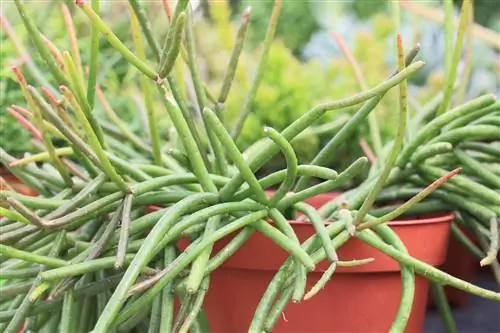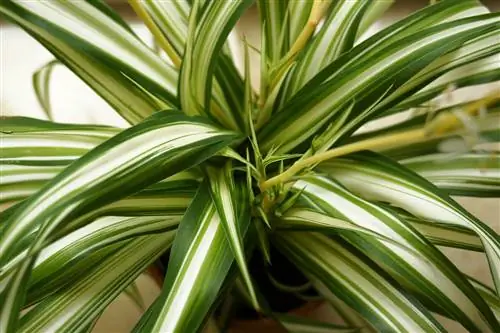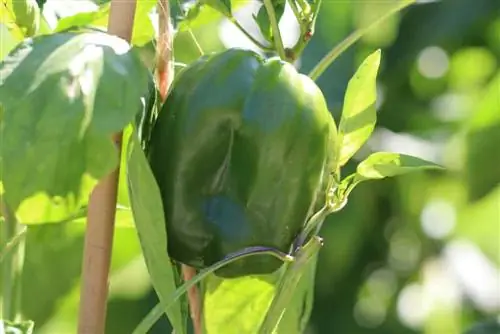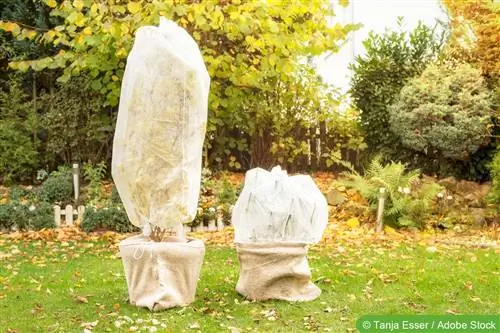- Author admin [email protected].
- Public 2023-12-17 03:39.
- Last modified 2025-01-24 12:45.
Rhipsalis cacti are leaf cacti and are better known as coral cactus, rush cactus, rod cactus or whip cactus. They mainly come from Central and South America. Some species also occur in Africa and Madagascar.
The genus Rhipsalis includes around 40 species. Most of them have hanging shoots, which is why the cacti are very suitable as hanging plants. The many flowers that form with good care are particularly beautiful. Although they are usually small, they occur in large numbers. After flowering, berry-like fruits form. Rhipsalis usually bloom in spring. However, further flowering may occur over the course of the year. Plants that are kept outdoors in summer are usually more willing to flower than those that are only kept as houseplants.
Care
Rhipsalis are generally easy to care for. They can easily be kept as houseplants. They do not hibernate and can stay warm all year round. Temperatures between 20 and 27 ËšC are ideal in summer. They need a bright to partially shaded location. Midday sun should be avoided, otherwise burns can occur on the leaves. Rhipsalis can be taken outside in summer, but then in a partially shaded location that should also be protected from rain and wind.
The cacti like high humidity. They usually cope quite well with humidity between 40 and 60 percent. If it's higher, that's better.
The planting substrate should be peat-based. To give the water better drainage, sharp sand should be mixed in.
The rhipsalis do not need much water. Wait until the soil has dried thoroughly before watering. However, the plant ball must not dry out. What you should definitely avoid is standing water. About 10 minutes after watering, excess water should be removed from the planters or saucers. Watering is usually required every 7 to 10 days. In summer, when temperatures are high, watering must of course be increased. Irrigation by dipping the bale in a bath is ideal. Hard water is not suitable. The plants love soft water. Clean rainwater is ideal.
Cactus fertilizer is suitable for fertilizing. You fertilize every 14 days to once a month, which is completely sufficient, but only during the time the buds are forming. As soon as some of the buds have opened, stop fertilizing.
Mealybugs often appear on Rhipsalis cacti. Collecting them is often difficult because the little pests are often overlooked. Usually only chemical control helps.
Wintering
The ideal temperatures for wintering are 16 to 20 ËšC. The rhipsalis should not be left too cold over the winter as this will affect growth. Watering is always done when the soil has dried thoroughly. However, the plant ball should not dry out completely. The cooler the cacti are, the less they need to be watered. Watering too little is much less dangerous than watering too much.
Propagate
Rhipsalis cacti are best propagated by cuttings. They are cut from spring to summer. To do this, cut off an 8 to 15 centimeter long shoot from the plant. This is planted directly in a suitable cactus substrate, about 3 to 4 centimeters deep. It is ideal to plant several cuttings close together. For the first few weeks, the plant substrate must be kept slightly moist. You can then treat the cuttings like adult specimens.
Are rhipsalis poisonous?
Rhipsalis are often confused with euphorbias. These are spurge plants. The milk that escapes when injured is more or less poisonous. Cacti do not secrete such milk. They are usually classified as conditionally toxic or unknown toxic. But you shouldn't eat Rhipsalis. Animals should also be kept away from the plants.






